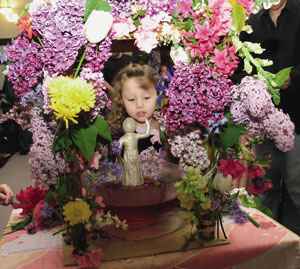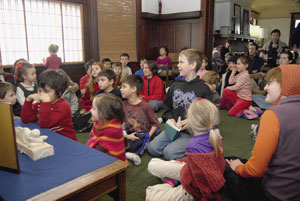IN the early 1980s, one of the members of our small Zen Center came to us complaining that there was nothing in our program designed for children or families with children. In fact, our whole program at that time was lifted directly from the schedule of our founder’s monastery and was only moderated in timing and intensity to accommodate people with jobs in Portland. Our early attempts to create some gaps into which children could be inserted showed our ignorance and were frustrating to the members. For instance, we tried family work/retreat days. The days were too long, boring, and structured in an adult monastic way to be engaging for the children. For the children, once was enough.
We also tried doing a serialized story reading of Journey to the West, the sixteenth-century Chinese novel about a monk’s travels to India, thinking a fantastic adventure story would be great. Once again, the format was too dull, adult, and slow to get to the good stuff; the material proved to be neither stimulating nor particularly relevant. Just as we were getting fed up with our ignorance and lack of skill, the same member who brought up this issue in the first place volunteered to organize a tour of venues where others had experience teaching religious themes to children. We visited several churches and a school, then read some books and articles from our county library. It was through this research that we began to piece together the structure and content of the Dharma School we have today.
Music

A great mnemonic device is to sing the thing to be remembered. Adults who were asked to remember their childhood experience of Sunday school noted that even if they recalled nothing else, they knew they had enjoyed the singing and retained the lessons from the songs. As Zen Buddhists, we have the difficult task of teaching terms and practices that are often enigmatic to children, who think and see in very concrete terms. Songs that use Buddhist terms and images allow us to introduce concepts in an enjoyable and openhanded way.
We begin every Dharma School session with a song that directs attention to the elements of devotional practice: the altar, flowers, incense, and gongs. The last song we sing before we go to meditation is called “Magic Circle,” and it takes a Taoist view on interconnectedness and emptiness. In the time between these two songs, the music director may take requests from the kids. The songs cover a variety of topics, such as the Four Noble Truths, respect, the paramitas (perfections), the Four Sights, meditation, change, and equanimity.
We had very little material to start with, but the resources are now quite rich and continue to grow. the first source we found for Buddhist music for a Sunday school program was the Jodo Shinshu (formerly Buddhist Churches of America). Many Jodo Shinshu temples have been running dharma school programs in America for close to a hundred years, and they have a songbook with songs for children in English and Japanese. Since then we have collected songbooks and tapes from a wide variety of Buddhist sources: Young Buddhist Association of Malaysia; the City of 10,000 Buddhas in Ukiah, California; and the work of Nathaniel Needle (CDs and songbooks are available through the Zen Buddhist Temple of Ann Arbor, Michigan). Some of the songs in these sources were based in different cultures and types of Buddhism, so we selected songs that worked for us or changed some of the words so they would be consistent with our use of terms and imagery. We have added to our collection a few familiar American songs and several very popular home-grown creations (including “We All Need Samadhi to Lean On”).

Kid-friendly Dharma Teachings
The director of a Montessori school who taught Catholicism as part of the curriculum advised us to sit down and make a list of important tenets and symbols of our religion. With this as a base, the teachers could pick out a few to form the core of the teaching for the children. Through experimentation and practice, we have discovered that the teachings that work best with children meet certain criteria:
First, the teachings must be something kids can relate to at their developmental level. Buddhism contains many teachings and concepts that can be interpreted in fairly simple and concrete terms even though they may simultaneously contain great depth and subtlety. An example of this is the story of the Buddha’s life, which can be enjoyed by children as a fine tale of someone trying to lead a good life and help others, without necessarily requiring them to grasp the significance of renunciation.
Second, the teachings should be life-affirming. We strongly believe that a child or young adult must be allowed to develop a healthy ego and self-esteem before he or she will be ready to consider “letting go” of that ego, as we aim to do in adult practice. Also, though the concept of suffering or dukkha(the inherent dissatisfactoriness of life) is central to Buddhist teaching, if we discuss it with children, we do so with a very light touch. This is the primary reason we don’t emphasize the basic Buddhist teachings of the Four Noble Truths and the Eightfold Noble Path, even though they look outwardly simple and ideal for children: whereas adults may be able to see how these are actually optimistic teachings, kids too frequently interpret them, more or less, as saying, “Life is going to be miserable for you, just like it was for us, so the sooner you get serious and stop enjoying it, the better.”
Third, the teachings should be illustrated by engaging stories and rich imagery, and there are a growing number of resources for teachers [see Resource Guide]. Many people trying to share dharma with children have looked to what seems an obvious source of ready-made material in the Jataka tales.
These are ancient Buddhist fairy tales that recount former lives of the Buddha, most of which date back to when Buddhism thrived in India. However, most people ultimately find the Jataka tales to be of limited usefulness in teaching dharma to children. For one, they are as dated and culturally flavored as European fairy tales, so there is often a culture gap to bridge. Second, though there are many Jataka tales, the virtues demonstrated in them are limited in scope and number: kindness, honesty, loyalty, and more loyalty.
Last, the teachings should be useful to children now, or open up topics that will be important to them in the future. Teachings about moral behavior and compassion are naturally useful to children, as long as they are not given too dogmatically. Other teachings may go a little over the heads of the younger kids, such as teachings about acceptance of death, illness, or loss. However, if these teachings can be conveyed in an engaging and age-appropriate way, we plant a seed in the kids’ minds. Later, when the issues raised become relevant or approachable, the kids can ask about and explore them in a more mature way. Creating an environment of respect and care.
Our program came alive when we remembered that there can be no influence if there is no relationship between people. At first, we were so focused on the dharma we were trying to teach that we ended up being grim and disconnected from the children. Now, our teachers first attempt to listen respectfully to the kids, honor who the kids are and where they are in their development, and adapt the dharma teaching to individuals. This helps to foster a sense in the kids that they are appreciated, supported, and safe when they are at the Zen Center. Singing, smiling, and sharing food are some of the other natural ways we communicate respect and care.
The most important aspect of the Dharma School program is often not the program itself but the culture created around the program. Every year when we start a new year of Dharma School, we ask the children to share the rules with new students. With a little prompting, they tell each other that we come in and take our shoes off; that we don’t hit or call each other bad names; that we share and take turns. These are simple rules, but they are crucial for the harmony of this community. Although stating these rules is important, the most meaningful method we have for teaching this is to model it.

Our teachers offer the form of meditation without pressure to make anything happen. We offer the practices of bowing, offering incense, and chanting without goals and expectations. A few minutes of our Dharma School program is given to meditation, offering incense, and bowing as a quiet ritual, or some other practice form that the teacher finds accessible to the particular group. The children are free to discover for themselves what this practice time has to offer, if anything. It helps to connect them to the quiet time their parents and teachers take to do meditation at home, at the Zen Center, and at retreats out of the city. Forging this connection may be reason enough to keep meditation practice a part of the routine of the children’s program. The rewards of introducing children to meditation practice have come in the natural course of events. Some of our children have come back as adults to practice with us in the meditation hall, take the Precepts, formally become Buddhists, and take refuge in the community.
Thank you for subscribing to Tricycle! As a nonprofit, we depend on readers like you to keep Buddhist teachings and practices widely available.